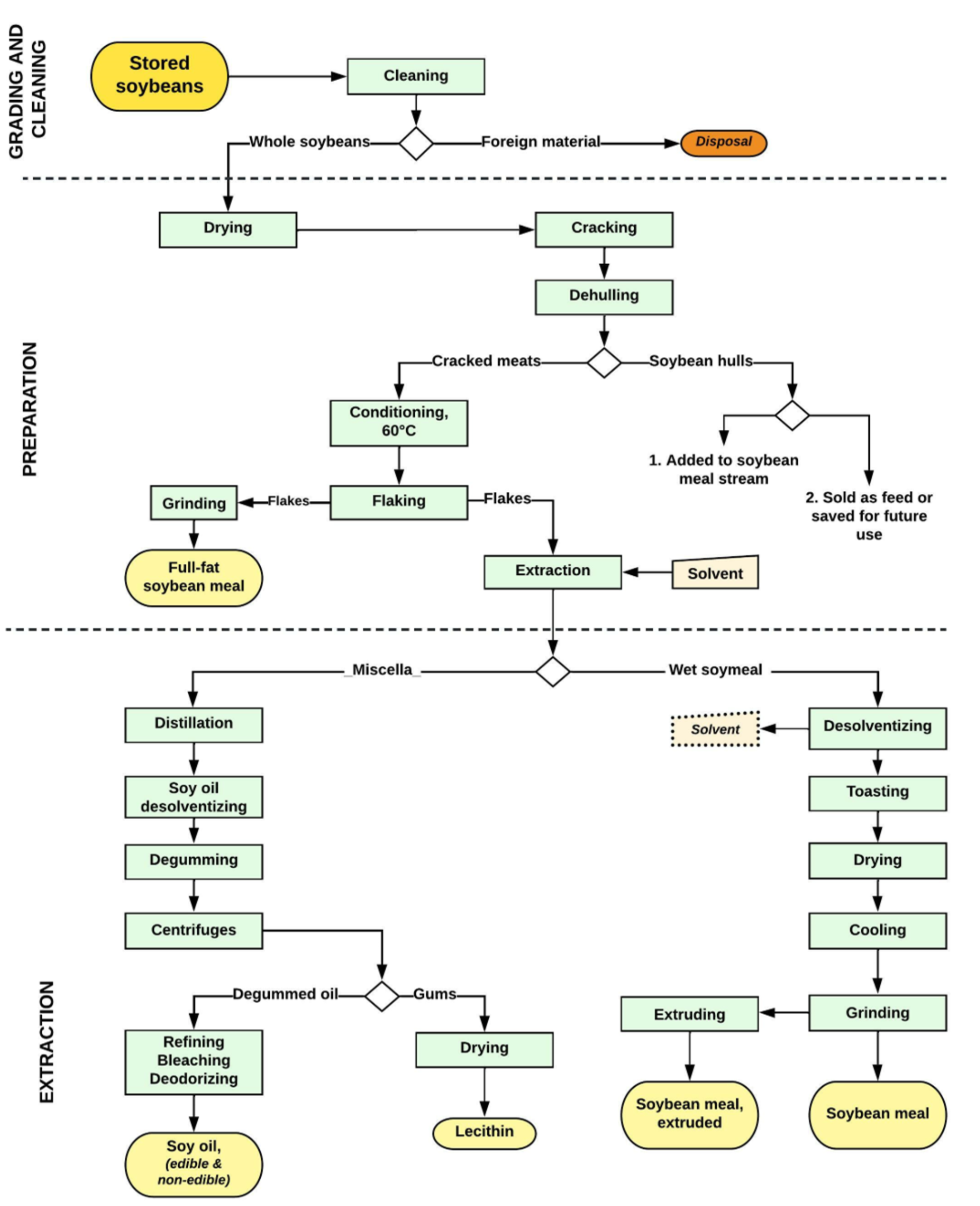⇦ Back to Livestock and Feedstuff Management Home
¶ Introduction
Nearly all soybeans are processed by solvent extraction procedures to separate the components and to produce both oil and the protein-carbohydrate-fiber meal. Processing a 60-pound bushel of soybeans will yield about 11 pounds of oil and 44 pounds of meal.
A typical solvent extraction, or crushing, operation can be divided into three steps:
- soybean preparation;
- oil extraction, and
- soybean meal formulation.
¶ Soybean Preparation
Soybeans are graded and cleaned before processing. Screening separates the whole soybeans from foreign material and fine particles.
Whole soybeans are cracked with a roller and broken into smaller pieces. This helps remove the hull and cracks bean meat to a size of 1 ⁄6 to 1 ⁄8 inch. This is small enough to remove hulls but coarse enough to limit the amount of meat fines.
All of the hulls and a fraction of the meat fines are removed via aspiration after the initial cracking step. Hulls are passed over a sifter and separated into three categories: (1) large hulls and meats, (2) small hulls and meats, and (3) fines. Fines return to the primary soybean stream.
The remaining hulls and meat fractions go to the secondary dehulling step. Dehulling removes the soybean meats, which then pass to the hull toaster to destroy urease activity.
The toasted hulls are is ground to the desired particle size and either pelleted or sold as bulk. Pelleting soybean hulls significantly reduces transportation cost, but many commercial feed companies prefer the unpelleted bulk form.
The soybean meats are conditioned to about 140 to 160°F and about 8.5% to 10% moisture for flaking. The meats pass through a set of rollers set to produce 0.01 to .015 inch thick.
¶ Oil Extraction
The flakes contain about 18% oil and are treated with an organic solvent, usually hexane, to extract the oil. The solvent is reclaimed to yield crude soybean oil. The oil is “degummed” to separate crude lecithin from the oil.
The soybean oil is further refined further to produce products such as cooking oil, margarine, and shortening. Extraction removes virtually all of the oil from the flakes. The defatted flakes are about 0.3% to 0.7% oil. The traces of solvent are from the flakes. The flakes are toasted to destroy the urease activity. The flakes (about 18% moisture) are now referred to as “soybean meal”.
The meal is toasted at about 200°F and dried to about 12% moisture, then cooled to about 100°F.
¶ Soybean Meal Formulation
The flakes are ground and screened to make soybean meal or a variety of soy protein products including soy flour, soy concentrates, and soy isolates.
The hulls that were removed earlier can be introduced to the soybean meal to lower the protein content to product specifications (44%). The remaining soybean hulls, sometimes referred to as “mill run”, can be saved for future use or sold.
¶ Figure 1. Soybean Processing & Products (flowchart)

¶ References
Blasi, et.al. 2000. Pub. No. MF2438, Soybean Hulls: Composition and Feeding Value for Beef and Dairy Cattle. Kansas State Univ. Coop. Ext., Manhattan. pp. 2-3. https://bookstore.ksre.ksu.edu/pubs/mf2438.pdf
National Oilseed Processors Assn. 2022. Unlocking the Power of the Seed: Oilseed Processing. https://www.nopa.org/oilseed-processing/